Boyer George R. An Economic History of the English Poor Law, 1750-1850
Подождите немного. Документ загружается.


The
Old
Poor
Law and
the Agricultural
Labor Market
137
tions model,
and
GRAIN
is
omitted.
11
Finally, WORKHOUSE
is in-
cluded
to
test
the
contention, often heard before parliamentary commit-
tees,
that indoor relief was more expensive than outdoor
relief.
12
Equation
(2)
tests
the
extent
to
which alternative sources
of
income,
various forms
of
outdoor
relief,
distance from urban labor markets,
and
surplus labor affected laborers' expected annual income.
The
variables
CINDUSTRY
and
ALLOTMENTS test whether labor-hiring farmers
responded
to the
existence
of
alternative (non-relief) sources
of
family
income
by
reducing wage rates.
Per
capita relief expenditure
was in-
cluded
in the
simultaneous equations model
to
test whether poor relief
was
a
substitute
for
wage income.
The
cost-of-migration hypothesis
sug-
gests that wage income,
as
well
as
relief expenditures, should
be
nega-
tively related
to
distance from London. Density
is a
proxy
for
"popula-
tion pressure
on the
land" (Mokyr 1985a: 45-6).
The
higher
the
density,
the lower
the
land-labor ratio
and,
given diminishing returns,
the
lower
the marginal product
of
labor. Density therefore
is
expected
to be
nega-
tively related
to
wage income.
The remaining four variables represent specific forms
of
outdoor
re-
lief,
each
of
which
is
expected
to
have
a
negative effect
on
wage income.
The existence
of
child allowances
for
laborers with large families should
have enabled farmers
to
reduce their wage payments
to a
level just high
enough
to
support
a
family
of
four
or
five. Allowances-in-aid-of-wages,
labor rates,
and
roundsmen systems
all
involved parish subsidization
of
farmers
who
employed laborers,
and
thus should have caused market
wage rates
to
decline.
A parish's unemployment rate should
be
determined
by its
crop
mix,
its degree
of
population pressure,
its
relief policies,
and the
availability
of alternative income sources.
The
more
a
parish specialized
in the
production
of
grain,
the
higher its unemployment rate should have been,
because
of the
highly seasonal nature
of
labor requirements
in
grain
production.
The
higher
the
degree
of
population pressure (that
is, the
lower
the
land-labor ratio),
the
more seasonally redundant laborers
there will
be for any
given crop
mix.
Density,
the
proxy
for
population
pressure, should therefore
be
positively related
to
unemployment.
11
GRAIN
is
omitted because
it
should affect relief expenditures only through
its
effect
on
the unemployment rate.
12
Of
course,
the
recipients
of
poor relief included widows
and old,
sick,
or
infirm persons
as well
as
able-bodied laborers
and
their families. Thus cross-parish variations
in per
capita relief expenditures could
be
caused
in
part
by
differences
in the
proportion
of
widows,
and so
on,
in the
parishes' populations. Unfortunately, lack
of
data have made
it
impossible
to
control
for
such differences.
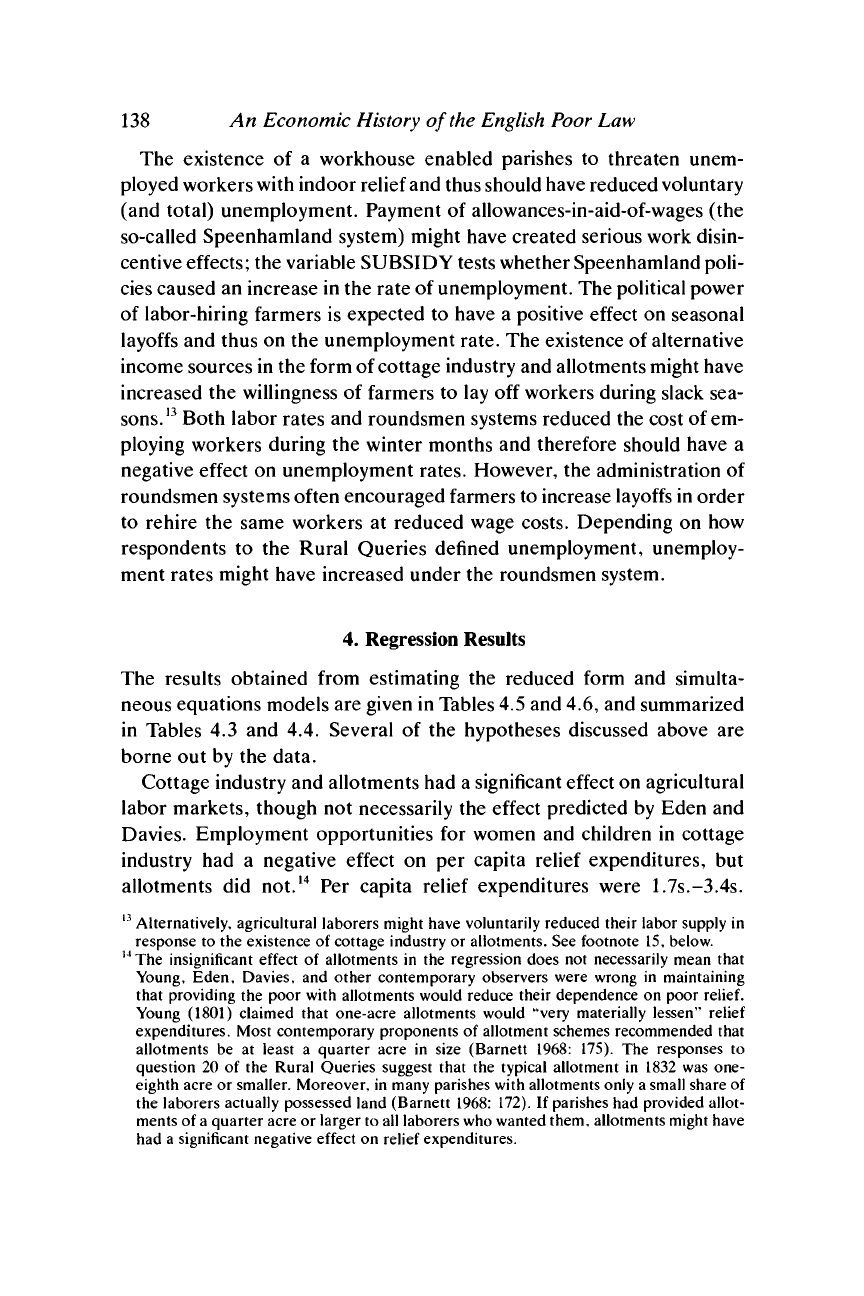
138 An Economic History of
the
English Poor Law
The existence of a workhouse enabled parishes to threaten unem-
ployed workers with indoor relief and thus should have reduced voluntary
(and total) unemployment. Payment of allowances-in-aid-of-wages (the
so-called Speenhamland system) might have created serious work disin-
centive effects; the variable SUBSIDY tests whether Speenhamland poli-
cies caused an increase in the rate of unemployment. The political power
of labor-hiring farmers is expected to have a positive effect on seasonal
layoffs and thus on the unemployment rate. The existence of alternative
income sources in the form of cottage industry and allotments might have
increased the willingness of farmers to lay off workers during slack sea-
sons.
13
Both labor rates and roundsmen systems reduced the cost of em-
ploying workers during the winter months and therefore should have a
negative effect on unemployment rates. However, the administration of
roundsmen systems often encouraged farmers to increase layoffs in order
to rehire the same workers at reduced wage costs. Depending on how
respondents to the Rural Queries defined unemployment, unemploy-
ment rates might have increased under the roundsmen system.
4.
Regression Results
The results obtained from estimating the reduced form and simulta-
neous equations models are given in Tables 4.5 and 4.6, and summarized
in Tables 4.3 and 4.4. Several of the hypotheses discussed above are
borne out by the data.
Cottage industry and allotments had a significant effect on agricultural
labor markets, though not necessarily the effect predicted by Eden and
Davies. Employment opportunities for women and children in cottage
industry had a negative effect on per capita relief expenditures, but
allotments did not.
14
Per capita relief expenditures were
1.7s.-3.4s.
13
Alternatively, agricultural laborers might have voluntarily reduced their labor supply
in
response
to the
existence
of
cottage industry
or
allotments.
See
footnote 15, below.
14
The insignificant effect
of
allotments
in the
regression does
not
necessarily mean that
Young, Eden, Davies,
and
other contemporary observers were wrong
in
maintaining
that providing
the
poor with allotments would reduce their dependence
on
poor
relief.
Young (1801) claimed that one-acre allotments would "very materially lessen" relief
expenditures. Most contemporary proponents
of
allotment schemes recommended that
allotments
be at
least
a
quarter acre
in
size (Barnett
1968: 175). The
responses
to
question
20 of the
Rural Queries suggest that
the
typical allotment
in 1832 was one-
eighth acre
or
smaller. Moreover,
in
many parishes with allotments only
a
small share
of
the laborers actually possessed land (Barnett 1968: 172).
If
parishes
had
provided allot-
ments
of
a
quarter acre
or
larger to
all
laborers who wanted them, allotments might have
had
a
significant negative effect
on
relief expenditures.
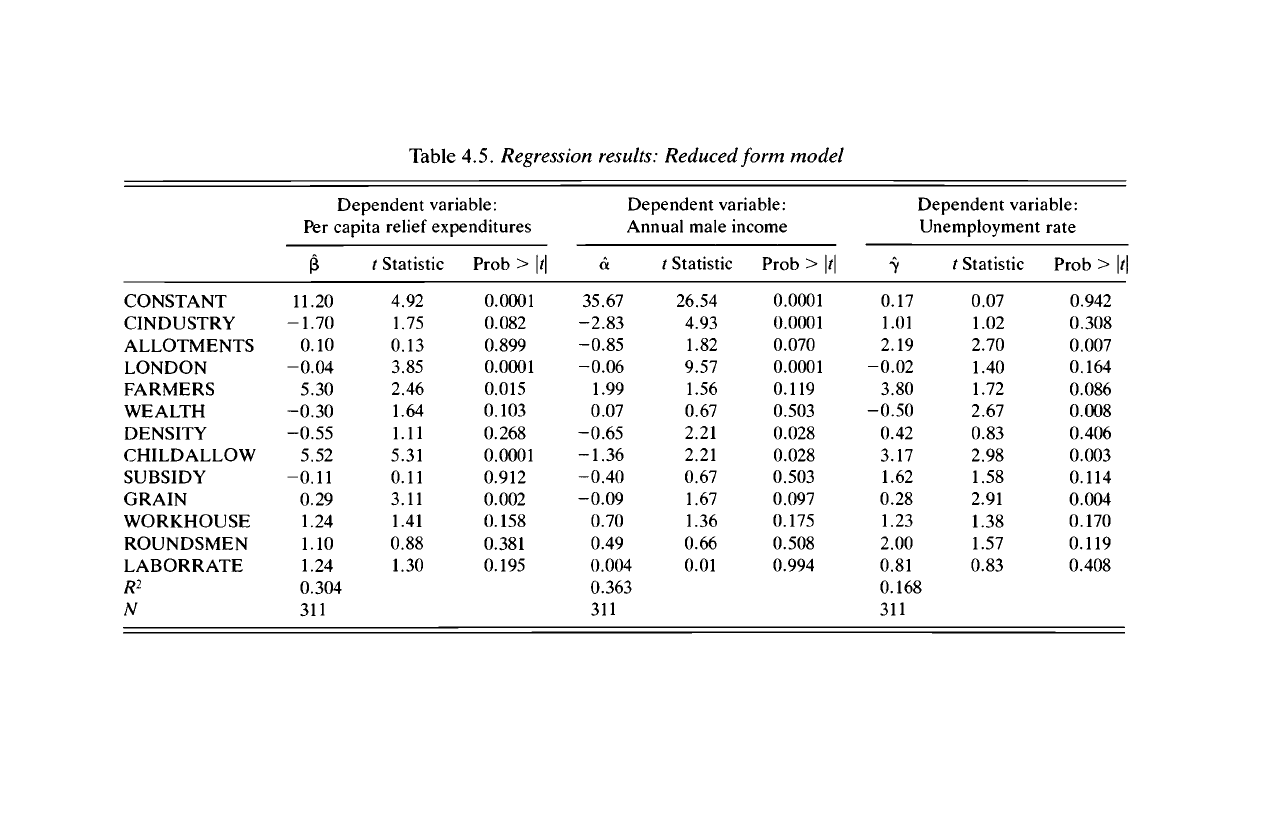
Table 4.5. Regression results: Reduced form model
CONSTANT
CINDUSTRY
ALLOTMENTS
LONDON
FARMERS
WEALTH
DENSITY
CHILDALLOW
SUBSIDY
GRAIN
WORKHOUSE
ROUNDSMEN
LABORRATE
R
2
N
Dependent variable:
Per capita relief expenditures
P
11.20
-1.70
0.10
-0.04
5.30
-0.30
-0.55
5.52
-0.11
0.29
1.24
1.10
1.24
0.304
311
t Statistic
4.92
1.75
0.13
3.85
2.46
1.64
1.11
5.31
0.11
3.11
1.41
0.88
1.30
Prob > t\
0.0001
0.082
0.899
0.0001
0.015
0.103
0.268
0.0001
0.912
0.002
0.158
0.381
0.195
a
35.67
-2.83
-0.85
-0.06
1.99
0.07
-0.65
-1.36
-0.40
-0.09
0.70
0.49
Dependent variable:
Annual male income
t Statistic
26.54
4.93
1.82
9.57
1.56
0.67
2.21
2.21
0.67
1.67
1.36
0.66
0.004 0.01
0.363
311
Prob >
\t\
0.0001
0.0001
0.070
0.0001
0.119
0.503
0.028
0.028
0.503
0.097
0.175
0.508
0.994
7
0.17
1.01
2.19
-0.02
3.80
-0.50
0.42
3.17
1.62
0.28
1.23
2.00
0.81
Dependent variable:
Unemployment
t Statistic
0.07
1.02
2.70
1.40
1.72
2.67
0.83
2.98
1.58
2.91
1.38
1.57
0.83
0.168
311
rate
Prob > \t
0.942
0.308
0.007
0.164
0.086
0.008
0.406
0.003
0.114
0.004
0.170
0.119
0.408
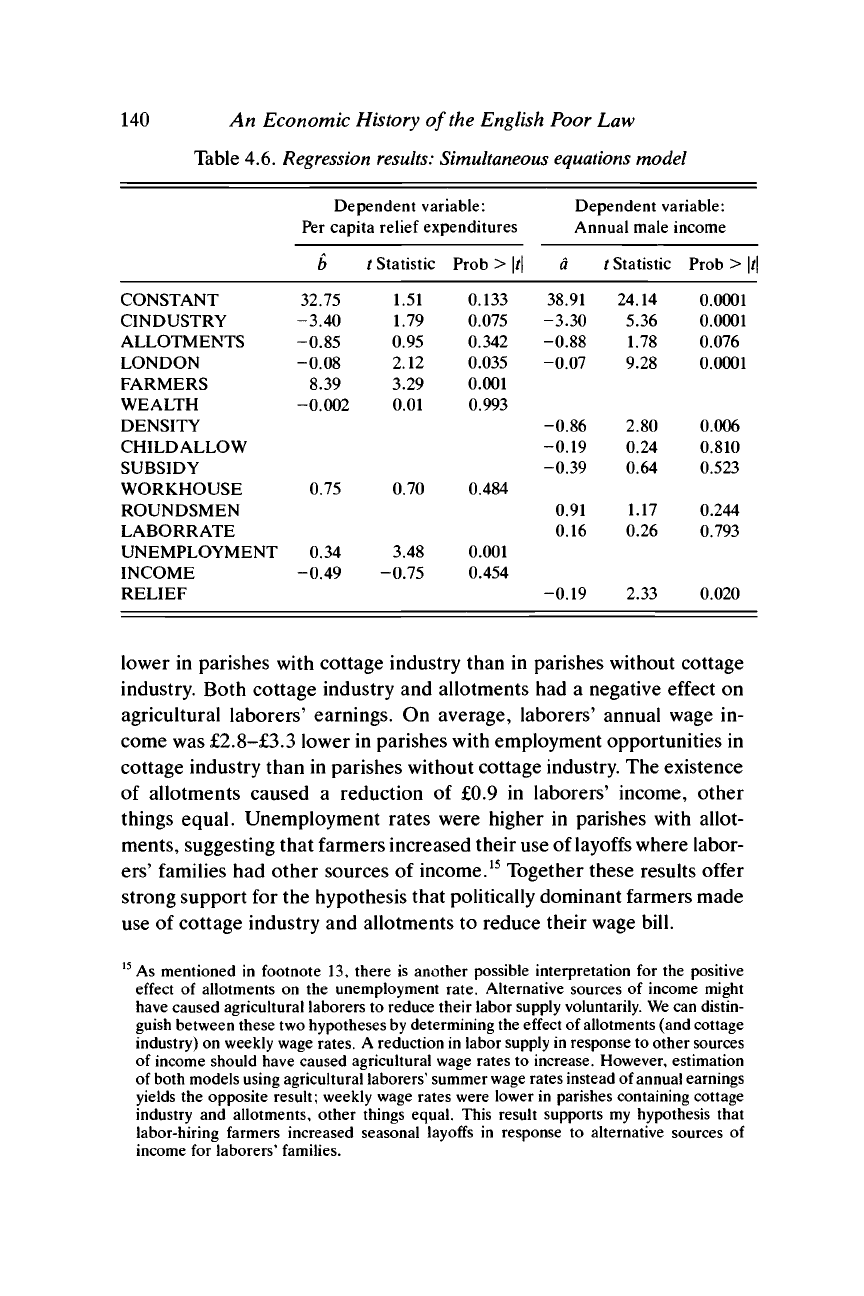
140 An Economic History of the English Poor Law
Table 4.6. Regression results: Simultaneous equations model
CONSTANT
CINDUSTRY
ALLOTMENTS
LONDON
FARMERS
WEALTH
DENSITY
CHILDALLOW
SUBSIDY
WORKHOUSE
ROUNDSMEN
LABORRATE
UNEMPLOYMENT
INCOME
RELIEF
Dependent variable:
Per capita relief expenditures
b
32.75
-3.40
-0.85
-0.08
8.39
-0.002
0.75
0.34
-0.49
t Statistic
1.51
1.79
0.95
2.12
3.29
0.01
0.70
3.48
-0.75
Prob > |r|
0.133
0.075
0.342
0.035
0.001
0.993
0.484
0.001
0.454
Dependent variable:
Annual male income
a
38.91
-3.30
-0.88
-0.07
-0.86
-0.19
-0.39
0.91
0.16
-0.19
/ Statistic
24.14
5.36
1.78
9.28
2.80
0.24
0.64
1.17
0.26
2.33
Prob >
\t\
0.0001
0.0001
0.076
0.0001
0.006
0.810
0.523
0.244
0.793
0.020
lower in parishes with cottage industry than in parishes without cottage
industry. Both cottage industry and allotments had a negative effect on
agricultural laborers' earnings. On average, laborers' annual wage in-
come was £2.8-£3.3 lower in parishes with employment opportunities in
cottage industry than in parishes without cottage industry. The existence
of allotments caused a reduction of £0.9 in laborers' income, other
things equal. Unemployment rates were higher in parishes with allot-
ments, suggesting that farmers increased their use of layoffs where labor-
ers'
families had other sources of income.
15
Together these results offer
strong support for the hypothesis that politically dominant farmers made
use of cottage industry and allotments to reduce their wage bill.
15
As mentioned in footnote 13, there is another possible interpretation for the positive
effect of allotments on the unemployment rate. Alternative sources of income might
have caused agricultural laborers to reduce their labor supply voluntarily. We can distin-
guish between these two hypotheses by determining the effect of allotments (and cottage
industry) on weekly wage rates. A reduction in labor supply in response to other sources
of income should have caused agricultural wage rates to increase. However, estimation
of both models using agricultural laborers' summer wage rates instead of annual earnings
yields the opposite result; weekly wage rates were lower in parishes containing cottage
industry and allotments, other things equal. This result supports my hypothesis that
labor-hiring farmers increased seasonal layoffs in response to alternative sources of
income for laborers' families.
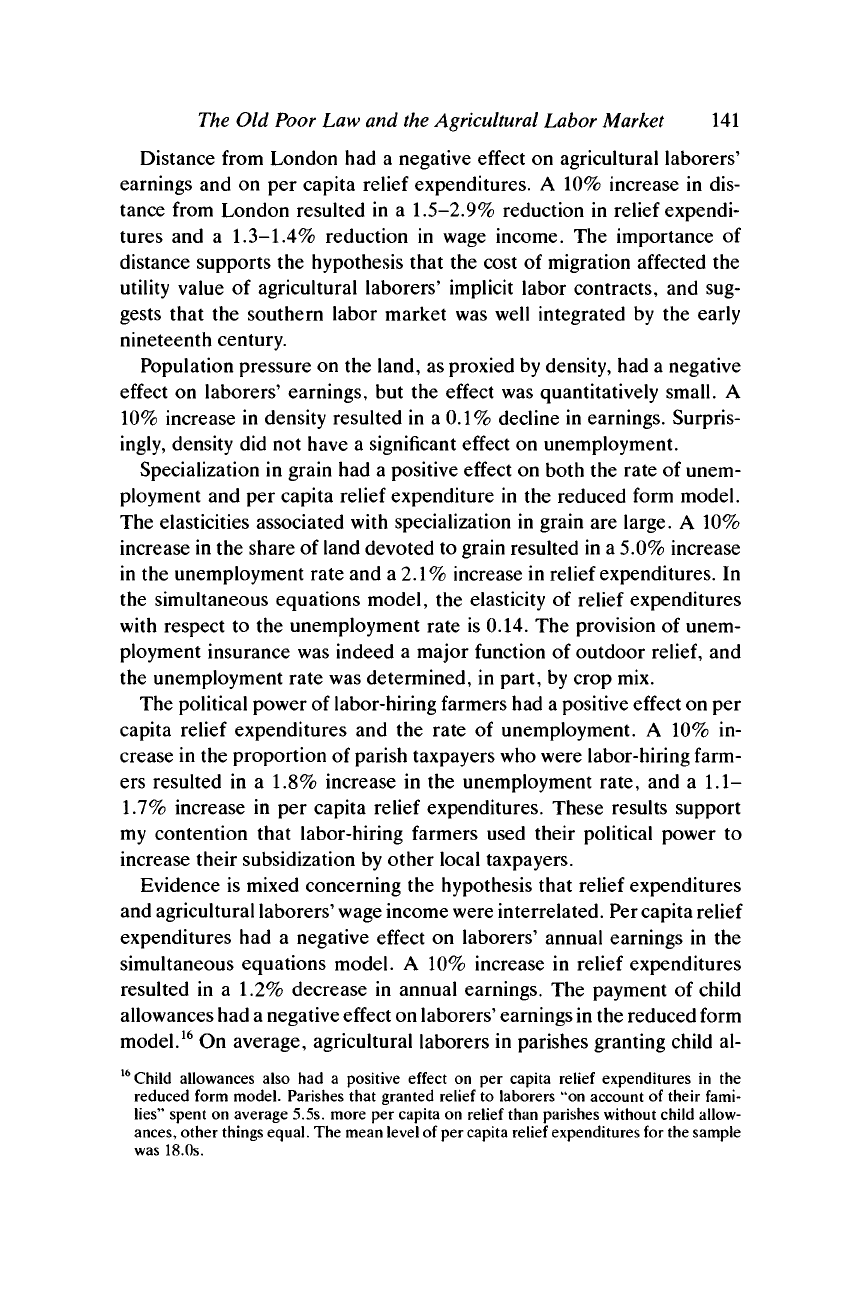
The Old Poor Law and the
Agricultural
Labor Market 141
Distance from London had a negative effect on agricultural laborers'
earnings and on per capita relief expenditures. A 10% increase in dis-
tance from London resulted in a
1.5-2.9%
reduction in relief expendi-
tures and a
1.3-1.4%
reduction in wage income. The importance of
distance supports the hypothesis that the cost of migration affected the
utility value of agricultural laborers' implicit labor contracts, and sug-
gests that the southern labor market was well integrated by the early
nineteenth century.
Population pressure on the land, as proxied by density, had a negative
effect on laborers' earnings, but the effect was quantitatively small. A
10%
increase in density resulted in a
0.1%
decline in earnings. Surpris-
ingly, density did not have a significant effect on unemployment.
Specialization in grain had a positive effect on both the rate of unem-
ployment and per capita relief expenditure in the reduced form model.
The elasticities associated with specialization in grain are large. A 10%
increase in the share of land devoted to grain resulted in a 5.0% increase
in the unemployment rate and a
2.1%
increase in relief expenditures. In
the simultaneous equations model, the elasticity of relief expenditures
with respect to the unemployment rate is 0.14. The provision of unem-
ployment insurance was indeed a major function of outdoor
relief,
and
the unemployment rate was determined, in part, by crop mix.
The political power of labor-hiring farmers had a positive effect on per
capita relief expenditures and the rate of unemployment. A 10% in-
crease in the proportion of parish taxpayers who were labor-hiring farm-
ers resulted in a 1.8% increase in the unemployment rate, and a 1.1-
1.7% increase in per capita relief expenditures. These results support
my contention that labor-hiring farmers used their political power to
increase their subsidization by other local taxpayers.
Evidence is mixed concerning the hypothesis that relief expenditures
and agricultural laborers' wage income were interrelated. Per capita relief
expenditures had a negative effect on laborers' annual earnings in the
simultaneous equations model. A 10% increase in relief expenditures
resulted in a 1.2% decrease in annual earnings. The payment of child
allowances had
a
negative effect on laborers' earnings in the reduced form
model.
16
On average, agricultural laborers in parishes granting child al-
16
Child allowances also had a positive effect on per capita relief expenditures in the
reduced form model. Parishes that granted relief to laborers "on account of their fami-
lies"
spent on average 5.5s. more per capita on relief than parishes without child allow-
ances,
other things equal. The mean level of per capita relief expenditures for the sample
was 18.0s.
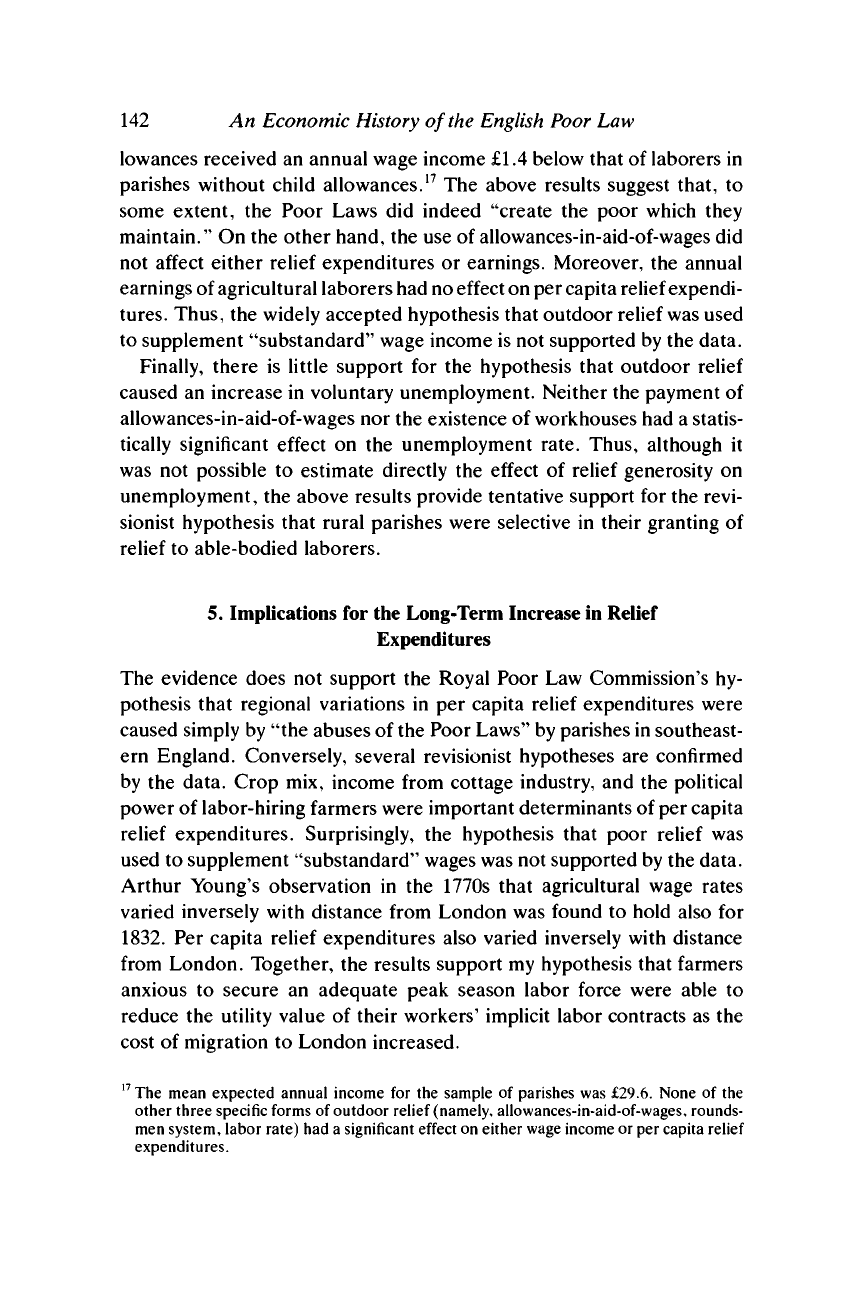
142 An Economic History of
the
English Poor Law
lowances received an annual wage income £1.4 below that of laborers in
parishes without child allowances.
17
The above results suggest that, to
some extent, the Poor Laws did indeed "create the poor which they
maintain." On the other hand, the use of allowances-in-aid-of-wages did
not affect either relief expenditures or earnings. Moreover, the annual
earnings of agricultural laborers had no effect on per capita relief expendi-
tures.
Thus, the widely accepted hypothesis that outdoor relief was used
to supplement "substandard" wage income is not supported by the data.
Finally, there is little support for the hypothesis that outdoor relief
caused an increase in voluntary unemployment. Neither the payment of
allowances-in-aid-of-wages nor the existence of workhouses had a statis-
tically significant effect on the unemployment rate. Thus, although it
was not possible to estimate directly the effect of relief generosity on
unemployment, the above results provide tentative support for the revi-
sionist hypothesis that rural parishes were selective in their granting of
relief to able-bodied laborers.
5. Implications
for the
Long-Term Increase
in
Relief
Expenditures
The evidence does not support the Royal Poor Law Commission's hy-
pothesis that regional variations in per capita relief expenditures were
caused simply by "the abuses of the Poor Laws" by parishes in southeast-
ern England. Conversely, several revisionist hypotheses are confirmed
by the data. Crop mix, income from cottage industry, and the political
power of labor-hiring farmers were important determinants of per capita
relief expenditures. Surprisingly, the hypothesis that poor relief was
used to supplement "substandard" wages was not supported by the data.
Arthur Young's observation in the 1770s that agricultural wage rates
varied inversely with distance from London was found to hold also for
1832.
Per capita relief expenditures also varied inversely with distance
from London. Together, the results support my hypothesis that farmers
anxious to secure an adequate peak season labor force were able to
reduce the utility value of their workers' implicit labor contracts as the
cost of migration to London increased.
17
The mean expected annual income
for the
sample
of
parishes
was
£29.6. None
of the
other three specific forms
of
outdoor relief (namely, allowances-in-aid-of-wages, rounds-
men system, labor rate)
had a
significant effect on either wage income
or
per capita relief
expenditures.

The Old Poor Law and the
Agricultural
Labor Market 143
What insights do the above results yield concerning the rapid increase
in per capita relief expenditures after 1750? For one thing, they enable
us to reject the contemporary notion that the increase in relief expendi-
tures was caused almost exclusively by the lax administration of outdoor
relief,
and its effects on wage rates, laborers' productivity, and voluntary
unemployment. The payment of allowances-in-aid-of-wages did not in-
crease unemployment rates or per capita relief expenditures, or reduce
laborers' earnings. The existence of workhouses did not reduce unem-
ployment rates. Moreover, although relief expenditures had a negative
effect on agricultural laborers' earnings, as the Poor Law Report main-
tained, earnings did not have a significant effect on relief expenditures.
But the major reason for rejecting the contemporary analysis is simply
that other factors ignored by the Poor Law Commissioners, such as
cottage industry and the extent of seasonal unemployment, were impor-
tant determinants of per capita relief expenditures.
The results also appear to reject the hypothesis that relief expendi-
tures increased in response to the decline in laborers' landholdings
caused by enclosures and other forms of engrossment. However, I noted
in Section 1 that, because of the small size of allotments in 1832, the
coefficient from the cross-sectional analysis understates the long-term
effect of laborers' loss of land. One cannot therefore ascertain the effect
of the decline in laborers' landholdings on per capita relief expenditures
from the cross-sectional analysis.
On the positive side, the regression results offer support for several
revisionist hypotheses. Long-term changes in crop mix, employment
opportunities or wage rates in cottage industry, the local political power
of labor-hiring farmers, urban wage rates, or cost of migration to Lon-
don could have caused relief expenditures to increase.
Parishes in the southeast of England responded to the long-term rise
in grain prices from 1760 to 1815 by increasing their specialization in
grain production (Snell 1981: 421-2). Because of the highly seasonal
labor demands of grain production, the change in crop mix must have
exacerbated the problem of seasonal unemployment. Indeed, Snell
(1981:
411) found that the seasonal distribution of male unemployment
became more pronounced over the period. The increased specialization
in grain was certainly an important factor in the increase in per capita
relief expenditures after 1760.
The political power of labor-hiring farmers increased in southern par-
ishes after 1760, as a result of changes in the economic and legal environ-

144 An Economic History of
the
English Poor Law
ment. The "long-term . . . consolidation of farms into larger and more
efficient units" that had begun in the seventeenth century was encour-
aged by the wave of enclosures between 1760 and 1815 (Chambers and
Mingay 1966: 92). The consequent decline in the number of small land-
holders increased the political power of labor-hiring farmers. The pas-
sage of Gilbert's Act (1782) introduced
u
the principle of weighting the
right to vote according to the amount of property occupied." This princi-
ple was extended by the 1818 Parish Vestry Act, which allowed rate-
payers up to six votes in vestry, depending on their poor rate assessment
(Brundage 1978: 7, 10). Because labor-hiring farmers were generally the
largest property holders in rural parishes, their political power was sig-
nificantly increased in parishes that adopted either of these acts. The
cross-sectional evidence suggests that farmers used their increased politi-
cal power to increase relief expenditures and therefore to pass more of
their labor costs on to non-labor-hiring ratepayers.
However, the most important cause of the increase in relief expendi-
tures probably was the combination of: (1) the decline in employment
opportunities and wage rates for women and children in cottage indus-
try, and (2) the rapid increase in London wage rates. From 1795 to 1832,
real wage rates of London builders' laborers increased by 44%.
18
During
the same period, the weekly earnings of an agricultural laborer's wife
and children in cottage industry declined from perhaps 2s.-5s. to 0s.-
3s.
19
The decline in cottage industry was most pronounced in East
Anglia, but the responses to question 11 of the Rural Queries show that
employment in cottage industry was declining throughout the south. The
conclusion here that the southern labor market was well integrated in
the early nineteenth century suggests that, in response to the decline in
cottage industry and the increase in London wage rates, farmers anxious
to secure an adequate peak-season labor force had to increase laborers'
wage rates or relief expenditures. The average weekly wage of southern
agricultural laborers increased from 8.8s. in 1795 to 10.6s. in 1832, which
was barely enough to offset the decline in earnings from cottage indus-
18
Nominal wage data
for
London laborers were obtained from Schwarz (1986: 37-8).
Cost-of-living data were obtained from Lindert
and
Williamson (1985: 148-9).
19
Estimates
of
the weekly earnings
of
women and children in cottage industry in
1795
were
obtained from Eden (1797). Estimates
of
weekly earnings
in
1832 were obtained from
the responses
to
question 11
of the
Rural Queries (Parl. Papers 1834: XXX). Question
11
also contains evidence that
by
1832
cottage industry had completely disappeared from
some areas
in
which
it had
flourished
in the
late eighteenth century.
For a
discussion
of
the long-term decline
in
wage rates
and
employment opportunities
in
cottage industry
see Chapter
1,
Section
3, and
Pinchbeck (1930: 138-45, 208,
220-1,
225).
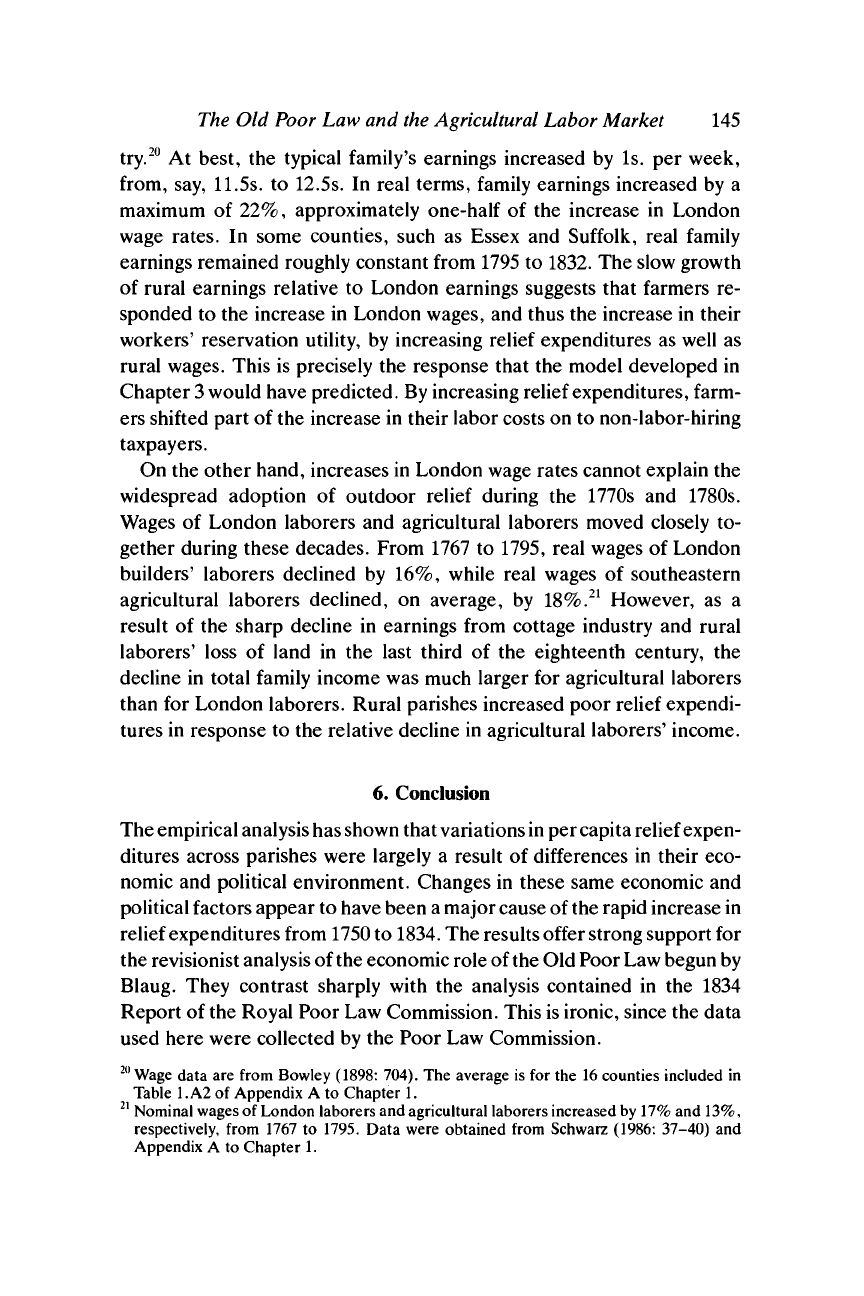
The Old Poor Law and the
Agricultural
Labor Market 145
try.
20
At best, the typical family's earnings increased by Is. per week,
from, say, 11.5s. to 12.5s. In real terms, family earnings increased by a
maximum of 22%, approximately one-half of the increase in London
wage rates. In some counties, such as Essex and Suffolk, real family
earnings remained roughly constant from 1795 to 1832. The slow growth
of rural earnings relative to London earnings suggests that farmers re-
sponded to the increase in London wages, and thus the increase in their
workers' reservation utility, by increasing relief expenditures as well as
rural wages. This is precisely the response that the model developed in
Chapter
3
would have predicted. By increasing relief expenditures, farm-
ers shifted part of the increase in their labor costs on to non-labor-hiring
taxpayers.
On the other hand, increases in London wage rates cannot explain the
widespread adoption of outdoor relief during the 1770s and 1780s.
Wages of London laborers and agricultural laborers moved closely to-
gether during these decades. From 1767 to 1795, real wages of London
builders' laborers declined by 16%, while real wages of southeastern
agricultural laborers declined, on average, by
18%.
21
However, as a
result of the sharp decline in earnings from cottage industry and rural
laborers' loss of land in the last third of the eighteenth century, the
decline in total family income was much larger for agricultural laborers
than for London laborers. Rural parishes increased poor relief expendi-
tures in response to the relative decline in agricultural laborers' income.
6. Conclusion
The empirical analysis
has
shown that variations
in
per capita relief expen-
ditures across parishes were largely a result of differences in their eco-
nomic and political environment. Changes in these same economic and
political factors appear to have been
a
major cause of the rapid increase in
relief expenditures from
1750
to
1834.
The results offer strong support for
the revisionist analysis of the economic role of the Old Poor Law begun by
Blaug. They contrast sharply with the analysis contained in the 1834
Report of the Royal Poor Law Commission. This is ironic, since the data
used here were collected by the Poor Law Commission.
20
Wage data
are
from Bowley
(1898:
704). The
average
is for the
16 counties included
in
Table
1.A2 of
Appendix
A to
Chapter
1.
21
Nominal wages
of
London laborers
and
agricultural laborers increased
by
17%
and
13%,
respectively,
from
1767 to 1795.
Data were obtained from Schwarz
(1986:
37-40)
and
Appendix
A to
Chapter
1.
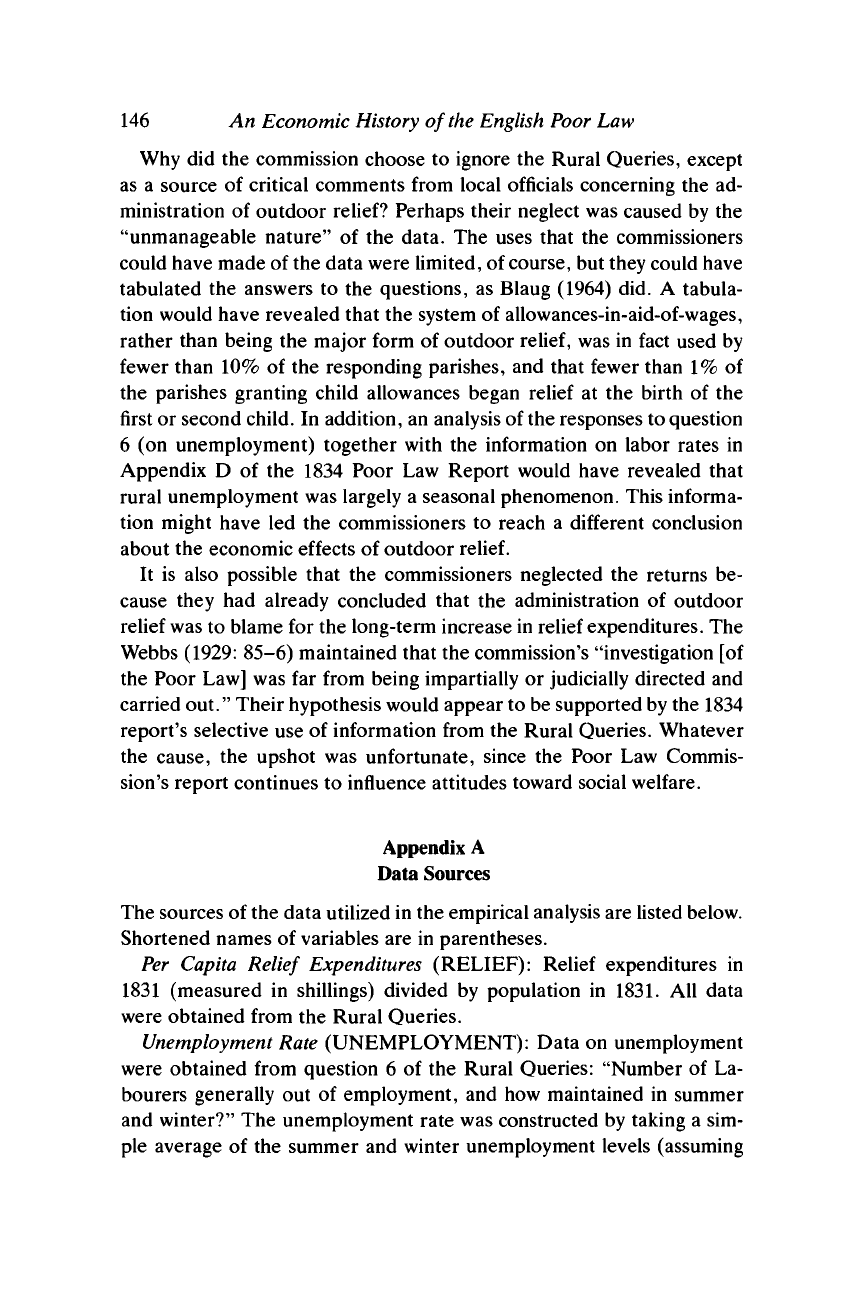
146 An Economic History of
the
English Poor Law
Why did the commission choose to ignore the Rural Queries, except
as a source of critical comments from local officials concerning the ad-
ministration of outdoor relief? Perhaps their neglect was caused by the
"unmanageable nature" of the data. The uses that the commissioners
could have made of the data were limited, of course, but they could have
tabulated the answers to the questions, as Blaug (1964) did. A tabula-
tion would have revealed that the system of allowances-in-aid-of-wages,
rather than being the major form of outdoor
relief,
was in fact used by
fewer than 10% of the responding parishes, and that fewer than 1% of
the parishes granting child allowances began relief at the birth of the
first or second child. In addition, an analysis of the responses to question
6 (on unemployment) together with the information on labor rates in
Appendix D of the 1834 Poor Law Report would have revealed that
rural unemployment was largely a seasonal phenomenon. This informa-
tion might have led the commissioners to reach a different conclusion
about the economic effects of outdoor
relief.
It is also possible that the commissioners neglected the returns be-
cause they had already concluded that the administration of outdoor
relief was to blame for the long-term increase in relief expenditures. The
Webbs (1929: 85-6) maintained that the commission's "investigation [of
the Poor Law] was far from being impartially or judicially directed and
carried out." Their hypothesis would appear to be supported by the 1834
report's selective use of information from the Rural Queries. Whatever
the cause, the upshot was unfortunate, since the Poor Law Commis-
sion's report continues to influence attitudes toward social welfare.
Appendix
A
Data Sources
The sources of the data utilized in the empirical analysis are listed below.
Shortened names of variables are in parentheses.
Per Capita Relief Expenditures (RELIEF): Relief expenditures in
1831 (measured in shillings) divided by population in 1831. All data
were obtained from the Rural Queries.
Unemployment Rate (UNEMPLOYMENT): Data on unemployment
were obtained from question 6 of the Rural Queries: "Number of La-
bourers generally out of employment, and how maintained in summer
and winter?" The unemployment rate was constructed by taking a sim-
ple average of the summer and winter unemployment levels (assuming
